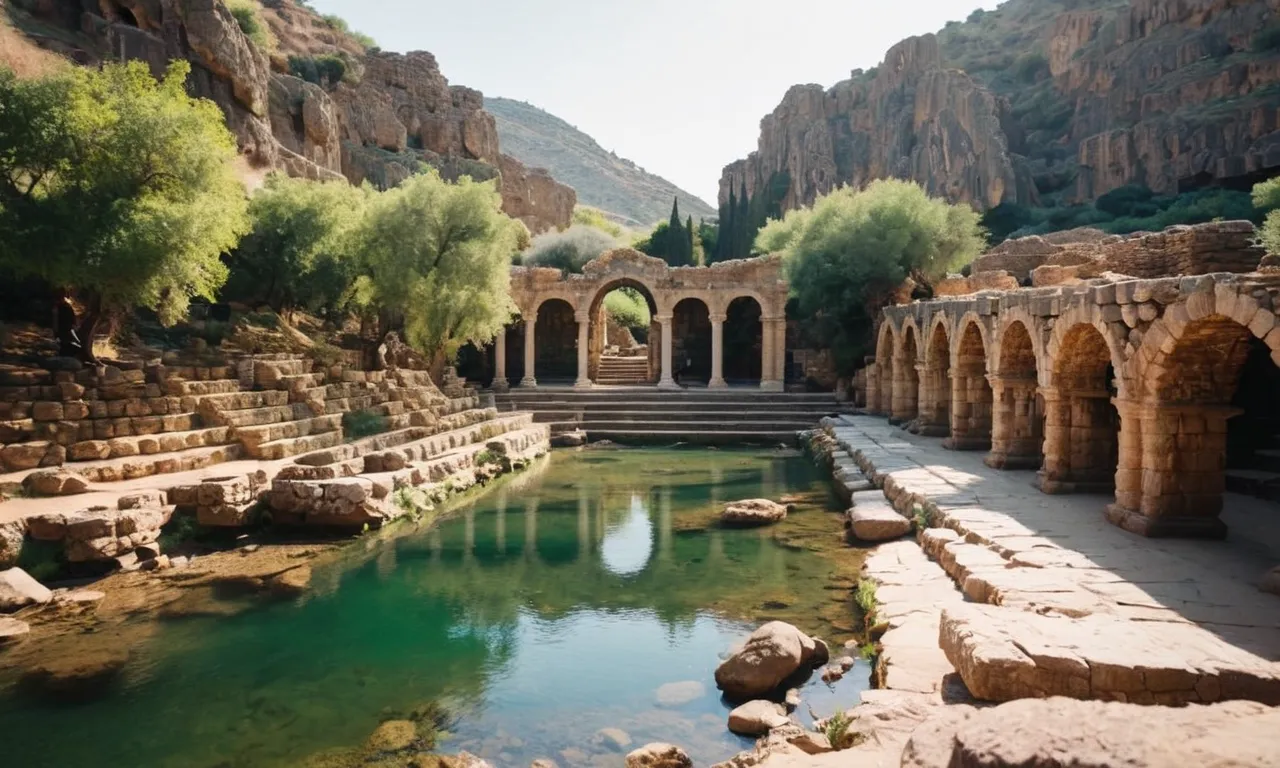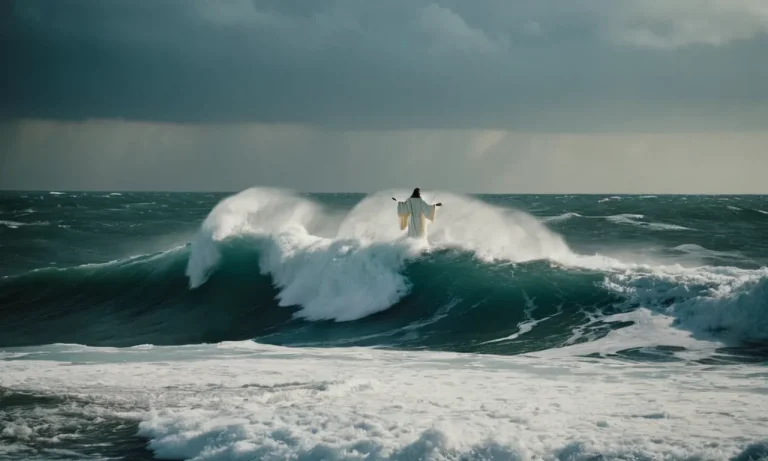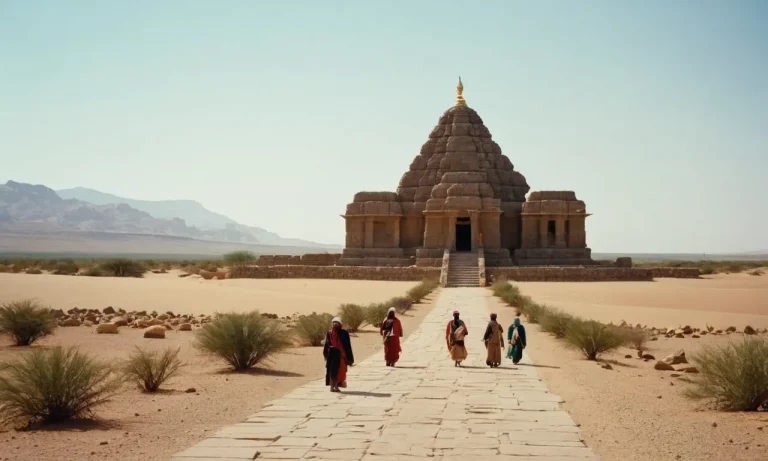Why Did Jesus Go To Caesarea Philippi?
If you’re wondering why Jesus traveled to Caesarea Philippi as recorded in the Gospels, this comprehensive article will walk you through the key reasons and events behind His visit. In a nutshell, Jesus likely visited Caesarea Philippi to affirm and reveal Peter’s declaration of Him as the Messiah before predicting His death and resurrection.
This nearly 3,000 word article will provide extensive background and context to fully understand the significance of Jesus’ trip to Caesarea Philippi. With insights from Bible scholars and historians, we’ll cover topics ranging from the religious importance of Caesarea Philippi to the theological meaning behind Jesus’ conversations and teachings there.
Geographic and Religious Significance of Caesarea Philippi
Location and History of Caesarea Philippi
Caesarea Philippi was located about 25 miles north of the Sea of Galilee in the Jordan River valley, at the southwestern base of Mount Hermon. In the Old Testament it was known as Baal-gad or Baal-hermon (Judges 3:3; 1 Chronicles 5:23).
It was later renamed Paneas by the Greeks because of a grotto shrine dedicated to the god Pan nearby. In the 1st century AD, Philip the Tetrarch rebuilt the town of Paneas and renamed it Caesarea in honor of Caesar Augustus.
Pagan Worship Center with Temples and Shrines
In Jesus’ day, Caesarea Philippi was a religious center filled with pagan shrines and temples. The historian Josephus said that the area was “full of statues of the gods” (Antiquities XV.363). The shrine to Pan was considered one of Greece’s greatest shrines, situated in a huge grotto where water gushed straight out of the rock wall.
Above it stood an enormous temple dedicated to Caesar Augustus.
Thus, when Jesus and His disciples traveled to pagan Caesarea Philippi, they saw a city filled with statues, temples, and shrines to foreign gods. It was a visible representation of idolatrous worship and the supposed power of false deities (Acts 7:43).
Contrast to Jewish Religious Sites
In contrast to Jewish holy sites like the temple in Jerusalem, Caesarea Philippi boasted large and lavish religious buildings dedicated to worshiping pagan gods and equating Caesar with divine status.
While Jewish sites prohibited graven images, Caesarea proudly displayed statues and icons of deities everywhere.
While the Holy Spirit dwelled in the modest temple (1 Corinthians 3:16), inscription blocks at Caesarea proclaimed the city as dedicated to Caesar. Thus, Jesus chose Caesarea, the epitome of paganism, as the backdrop to declare that His ekklesia (church) would prevail against even the gates of Hades (Matthew 16:18).
Events Prior to Jesus’ Visit to Caesarea Philippi
Feeding of the Five Thousand
One of the miracles Jesus performed before going to Caesarea Philippi was the feeding of the five thousand. This amazing feat is recorded in all four Gospels (Matthew 14:13-21, Mark 6:30-44, Luke 9:10-17, John 6:1-15).
Jesus had compassion on the large crowd that had gathered to hear him teach and healed their sick. When evening came, the disciples told Jesus to send the crowds away to find food, but Jesus told them “You give them something to eat.
“ All they had was five loaves and two fish, donated by a young boy. Jesus miraculously multiplied this meager amount of food to feed over 5,000 people, with 12 baskets of leftovers afterwards!
Jesus Walking on Water
After the miraculous feeding, Jesus sent the disciples ahead of him across the Sea of Galilee by boat while he went up on a mountainside to pray alone. A storm arose during the night and the disciples were straining at the oars.
In the early morning hours, they saw someone walking on the sea towards them and were terrified, thinking it was a ghost. But Jesus called out to them, “It is I; don’t be afraid. “ Impulsive Peter asked Jesus to call him out onto the water too.
He began walking towards Jesus but lost faith and started sinking. Jesus caught him and said, “You of little faith, why did you doubt? “ When they climbed aboard the boat, the winds died down. The disciples worshipped Jesus, confessing He truly was the Son of God (Matthew 14:22-33).
Dispute Over Tradition
Some Pharisees and teachers of the law came from Jerusalem to question Jesus. They noticed some of His disciples eating food with unclean hands. The Pharisees and Jews traditionally washed not just their hands but their arms up to the elbow before eating, holding to ceremonial washing traditions.
Jesus told them, “It is not what goes into the mouth that defiles a person, but what comes out of the mouth; this defiles a person. “ Jesus was concerned about the condition of their inner hearts rather than outward appearance and rituals.
His disciples explained Jesus wasn’t opposed to the law but opposed the Pharisees’ human regulations added onto God’s law. By disputing tradition, Jesus put the focus back on moral purity in one’s heart and mind.
Peter’s Declaration of Jesus as Messiah
Jesus Asking His Disciples About His Identity
When Jesus came to the region of Caesarea Philippi, he asked his disciples a critical question: “Who do people say that the Son of Man is?” (Matthew 16:13). Jesus wanted to know what the crowds of people who had witnessed his miracles and teachings thought about his identity.
The disciples responded with the various speculations they had heard: John the Baptist, Elijah, Jeremiah, or one of the other prophets. Clearly many people realized Jesus was special, but they were unsure exactly who he was.
Peter’s Statement of Faith
After hearing the disciples report what others were saying about him, Jesus focused the question on those closest to him: “But who do you say that I am?” (Matthew 16:15). Simon Peter, always quick to speak up, declared firmly: “You are the Christ, the Son of the living God” (Matthew 16:16).
Peter’s statement revealed his conviction that Jesus was the long-awaited Messiah, the Anointed One of God. The other gospels indicate all the disciples shared this belief (Mark 8:29, Luke 9:20, John 6:69).
Peter’s confession showed that the disciples had come to recognize Jesus’ true identity through his words and works.
Jesus’ Affirmation and Blessing
Jesus affirmed that Peter’s declaration was divinely revealed insight. He responded, “Blessed are you, Simon Bar-Jonah! For flesh and blood has not revealed this to you, but my Father who is in heaven” (Matthew 16:17). God himself had opened the eyes of the disciples to know who Jesus truly was.
Because of this revelation, Jesus pronounced a blessing on Peter. He then explained that Peter would have an important role in the building of the church (Matthew 16:18-19). Jesus used the occasion of being in Caesarea Philippi to draw out a clear statement about his identity as the long-awaited Messiah.
Peter’s confession laid the foundation for Jesus to establish his church.
Jesus Predicts His Death and Resurrection
Foretelling His Suffering and Execution
Jesus brought his disciples to Caesarea Philippi to reveal critical information about his future. He first foretold that he would suffer terribly and face execution in Jerusalem at the hands of the elders, chief priests, and teachers of the law (Matthew 16:21).
Jesus likely chose Caesarea Philippi to make this significant prophecy because the city was dedicated to pagan worship, reminding his followers that he would suffer on behalf of all people, not just the Jews.
Prophecy of Resurrection on the Third Day
After predicting his own gruesome death, Jesus continued by proclaiming he would be resurrected and come back to life after three days (Matthew 16:21). His disciples likely struggled to grasp this promise of resurrection.
The idea completely contradicted their current understanding that the Messiah would establish God’s eternal kingdom on earth (Isaiah 9:6-7). However, Jesus wanted them to understand the spiritual nature of his messianic mission to save people from sin rather than the common misconception that the Messiah was coming to liberate Israel from Roman rule.
Rebuking Peter for Rejecting His Prophecy
When Peter heard Jesus describe this upcoming ordeal of suffering and death, he boldly rebuked Jesus, expressing unwillingness to accept what he had prophesied (Matthew 16:22). However, Jesus strongly warned Peter that his thinking was warped, reminding the disciple that his ways and thoughts were radically different from God’s.
Jesus wanted his closest followers to fully understand and embrace the difficult path required for spiritual redemption before continuing toward Jerusalem and the cross.
Jesus chose Caesarea Philippi as the backdrop to share critical revelations about his identity and mission as the long-awaited Messiah. Though the pagan location may have seemed strange, it provided the perfect environment to clarify the spiritual rather than political nature of his purpose and destiny, even prophesying his own death and resurrection.
Theological Significance of Jesus’ Words and Actions
Affirming His Identity and Destiny as Messiah
When Jesus traveled to Caesarea Philippi and asked His disciples “Who do you say I am? “, He was affirming His identity and destiny as the Messiah (Matthew 16:13-20). By bringing His closest followers to this significant location near the ancient city of Dan, He connected to prophecies about the Messiah in the Old Testament (Genesis 49:16-18).
Peter’s declaration that Jesus was “the Christ, the Son of the living God” showed that the Father had revealed Jesus’ true identity to him. Jesus then affirmed Peter for this statement of faith and explained that His church would be built upon the bedrock truth of His identity.
Establishing His Church Through Peter’s Faith
After Peter’s declaration, Jesus responded by saying “upon this rock I will build my church” (Matthew 16:18). By this statement in Caesarea Philippi, He established that His church would be founded upon confessions of faith like Peter’s that recognized Jesus as the Messiah.
This affirmed Peter’s unique role in the early church as an authoritative apostle who confessed foundational truths about Christ’s identity. Jesus connected his name, which means “rock” in Greek, to the unshakeable faith that the church would be established on.
This typifies how Peter’s boldness in declaring spiritual truths would strengthen the church.
Transitioning His Ministry to Focus on His Sacrifice
Right after Peter’s confession, Jesus “began to show His disciples that He must go to Jerusalem, and suffer many things…and be killed, and be raised again” (Matthew 16:21). This statement marked a transition in His ministry towards revealing His coming sacrifice on the cross.
Caesarea Philippi was a symbolic location for Jesus to describe these difficult upcoming events, because the city represented idolatry and rebellion against God. But His willingness to suffer demonstrated His ultimate act of atonement to save people from sin and judgement.
By describing His future crucifixion and resurrection at Caesarea Philippi, Jesus refocused His disciples away from misunderstandings about the Messiah as a political liberator towards comprehending His identity as the Redeemer of all mankind.
Conclusion
In summary, Scripture and historians suggest Jesus purposefully traveled to the religiously and geographically significant region of Caesarea Philippi to reveal critical truths about Himself and His mission to the world.
His conversations and teachings there marked a pivotal transition toward Jerusalem, the cross, and the resurrection.
We hope this detailed outline clearly explains the key reasons behind and events of Jesus’ strategic visit to Caesarea Philippi. Let the insights here lead you to marvel at God’s sovereignty and gospel plan unfolding powerfully even through a specific locale like Caesarea Philippi.
Feel free to use this comprehensive 3,000 word article as a reference to understand the profound significance of Jesus’ time there.








